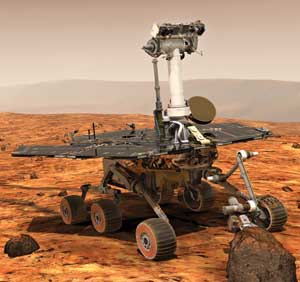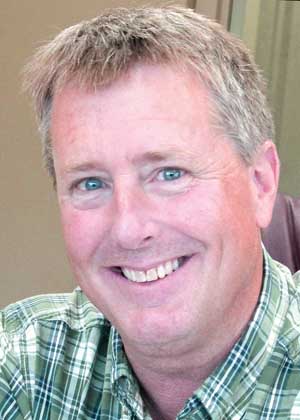
An artist’s concept portrays a NASA Mars Exploration Rover on the surface of Mars. (Courtesy NASA/JPL/Cornell University/Maas Digital)
As horticulturist Brent Milne watched a television documentary about robots on Mars, he had a vision of where the tree fruit industry might be headed.
A decade ago the National Aeronautics and Space Administration sent two robots, Spirit and Opportunity, to Mars to explore the planet’s surface. Like human geologists, the robotic rovers were able to scout surroundings for interesting rocks and soils, move toward them, and examine them. They carried “rock abrasion tools” (hammers) for removing the weathered surfaces of rocks so they could examine the interior, along with much more sophisticated tools to monitor the environment.
“If you let your mind wander a little bit, you could see a point in time where you could have a mass of robots in the orchard,” said Milne, who is assistant orchard manager with McDougall and Sons in Wenatchee, Washington.
He imagines that robots could be trained to do orchard tasks. For example, one robot might be able to scout up and down the rows looking for a certain pest and call in other robots to do spot spraying.

Brent Milne
“You would be managing a group of inexpensive robot knock-offs that would be able to communicate with each other,” Milne said. “If you let your mind wander, there are a lot of cool scenarios like that.
“If they can go and remotely explore Mars with these types of robots, we can certainly turn that technology around and use it here on Earth to manage our orchard blocks,” he added. “I think the pressures that are on us as an industry are going to start making these things not seem so far out much sooner. At some point, these have to be affordable and knockoffable, and that’s when this technology will be picked up and implemented.”
Monitoring
High-tech monitoring tools are already being used in other crops, but Milne said remotely identifying areas of the orchard with problems such as pests, water stress, or poor growth is only useful if the grower has the ability to take action in specific parts of the orchard.
For example, McDougall has a remote monitoring system for frost control. At its Mattawa orchard, it could have as many as 15 or 20 probes, but it only has three because, when they reach the critical temperature, water is switched on for the whole orchard. The three probes are in the sites most vulnerable to frost.
With densities of 1,800 or 2,000 trees per acre, it’s difficult to imagine humans managing individual trees or even small parts of the orchard separately, he said.
“It’s going to have to be something that makes sense from an efficiency point of view,” he said. •






Leave A Comment